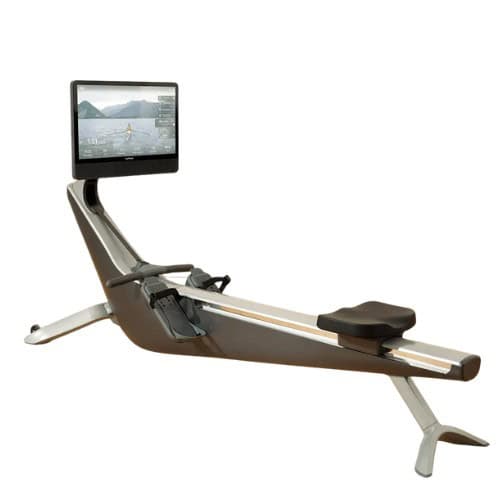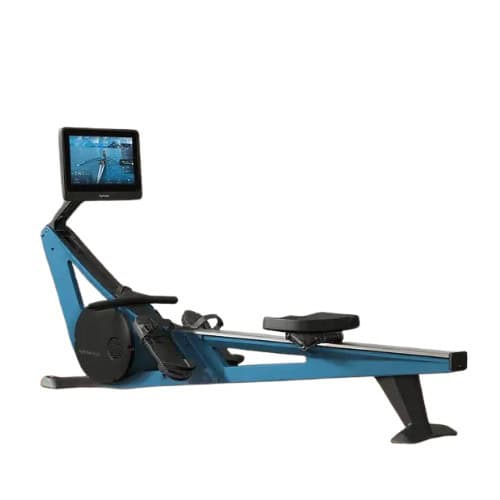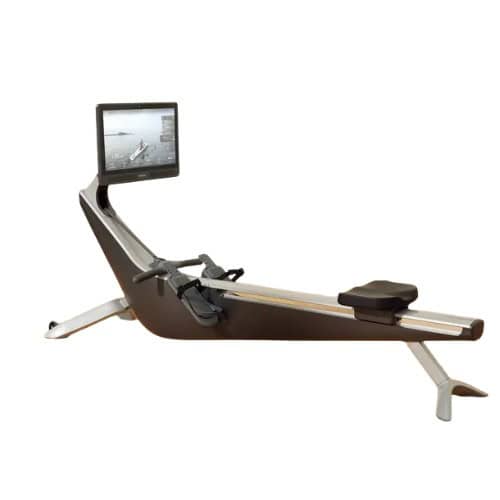The Hydrow membership is pretty much vital if you’re going to purchase a rower, here’s whether the $44/month subscription justifies the premium price.
The Hydrow membership costs $44 per month. That’s $528 per year. Over five years, you’ll spend $2,640 on content access alone.
Is it worth it?
After using Hydrow’s All-Access membership for months, taking dozens of live classes, testing the app on multiple devices, and comparing the experience to rowing without a subscription, I can give you a clear answer.
For most people who buy a Hydrow: yes, the membership is worth it. But only if you actually use the content regularly.
The membership isn’t optional in any practical sense. Without it, you’re stuck with “Just Row” mode, a bare-bones experience with basic metrics and no video content. At that point, you’ve paid $1,500-2,300 for a rower that functions like a $200 magnetic rower from Amazon.
The real question isn’t whether you need the membership (you do). It’s whether Hydrow’s content, instructors, and app features justify the premium price compared to alternatives like Peloton Row or a Concept2 with free YouTube rowing videos.
What You Get for $44/Month
The Hydrow All-Access membership includes:
- 5,000+ on-demand workouts (rowing, strength, yoga, Pilates, stretching, mobility)
- Live classes scheduled daily (limited schedule, but available)
- Unlimited user profiles for your household
- Performance tracking and metrics for all workouts
- Community features (leaderboards, challenges, badges, team competitions)
- Mobile app access (iOS and Android) for off-rower workouts
- Apple Health and Strava integration for syncing workout data
The membership covers everyone in your household. You can create separate profiles for multiple users, each with their own workout history, progress tracking, and personalized recommendations.
The Workout Library: What’s Actually Available
Hydrow organizes workouts into clear categories that make it easy to find what you’re looking for.
Rowing Workouts
This is the core of Hydrow’s content, and it’s where the membership shines.
Breathe: Steady-state cardio rows at moderate intensity. These are 20-45 minute sessions filmed on water in locations around the world. You’re rowing alongside an instructor through rivers in Sweden, lakes in Switzerland, or coastal routes in Chile.
The outdoor filming is genuinely immersive. You’re not staring at a studio wall. You’re watching the water move, seeing the landscape change, and hearing the instructor’s oar hit the water in rhythm with yours.
Sweat: Interval workouts alternating between hard efforts and recovery. These are typically 20-30 minutes and focus on building cardiovascular fitness and power output.
Drive: High-intensity interval training with short, maximal efforts. These are brutal. 10-20 minutes of all-out sprints with minimal recovery. Not for beginners.
Warm-ups and Cool-downs: 5-10 minute sessions for starting and ending workouts properly.
Distance Rows: Set a specific distance (e.g., 2000m, 5000m) and row with an instructor pacing you through it.
Journey Rows: Unguided scenic rows where you control the pace while watching outdoor footage. No instructor, just the environment.
I’ve done 50+ rowing workouts across these categories, and the variety keeps things interesting. The outdoor filming genuinely makes a difference compared to studio-shot classes.
Off-Rower Workouts
Hydrow includes substantial non-rowing content:
Strength Training: Full-body, upper body, lower body, and core-focused sessions. These range from 10-30 minutes and use bodyweight, dumbbells, or resistance bands.
The strength programming is solid but not exceptional. If you’re a serious strength athlete, you’ll find these workouts too basic. But for general fitness and complementing rowing, they’re adequate.
Yoga: Flow (dynamic movement), Align (form-focused), and Restore (relaxation and stretching). Sessions run 10-45 minutes.
The yoga content is better than I expected. Instructors provide clear cues, the classes are well-structured, and there’s genuine variety in difficulty levels.
Pilates: Core stability, flexibility, and posture work. These are typically 10-20 minutes.
Stretching and Mobility: 5-15 minute sessions for recovery and flexibility.
Circuit Training: Combines short rowing intervals with strength exercises. High energy, full-body focus.
I use the off-rower content 2-3 times per week, primarily for strength and stretching. It’s convenient to have everything in one app rather than switching between multiple subscriptions.
The Instructors: What Makes Them Different
Hydrow’s instructors are Olympians and elite rowers. This matters more than you’d think.
When you’re learning rowing technique, having an instructor who actually competed at the highest level provides credibility and detailed technical feedback that generic fitness coaches can’t match.
Notable instructors I’ve trained with:
- Aquil Abdullah: Olympian, great technical cues, calm demeanor
- Dani Hansen: Elite rower, energetic, excellent for interval work
- Nick D’Antoni: Multiple national championships, clear instruction style
- Ava Kovach: Olympian, strong focus on form and power application
The instruction quality is consistently high. They explain the catch, drive, and recovery phases clearly. They correct common mistakes in real-time. They motivate without being annoying.
This is where Hydrow differentiates itself from cheaper alternatives. You’re not just watching someone row. You’re learning from athletes who’ve spent decades mastering the sport.
Live Classes vs On-Demand: What’s the Difference?
Hydrow offers both live and on-demand classes.
Live classes are scheduled throughout the day. During a live class, you see a real-time leaderboard showing where you rank against other members currently taking the class. You can give and receive “cheers” (basically likes) during the workout.
The live element adds accountability. Knowing other people are rowing alongside you makes it harder to quit early or phone it in.
On-demand classes are recorded sessions you can take anytime. You still see leaderboards, but they show everyone who’s ever taken that class, so your ranking is less meaningful.
I take about 70% on-demand and 30% live. Live classes are motivating, but on-demand offers more flexibility for scheduling.
The Mobile App: How It Works
The Hydrow app (iOS and Android) provides access to all off-rower workouts. You can do strength training, yoga, Pilates, and stretching sessions without the rower.
Key app features:
- Full workout library browsable by type, duration, instructor, and difficulty
- Performance history and progress tracking
- Apple Health and Strava integration (syncs workout data automatically)
- Apple Watch support (tracks heart rate and displays it on the rower screen)
- Social features (follow friends, join challenges, earn badges)
The app works well. The interface is clean, navigation is intuitive, and syncing between devices is seamless.
I use the app 3-4 times per week for off-rower workouts when I don’t have time for a full rowing session. Being able to do a 15-minute strength workout or 10-minute yoga session through the same app is convenient.
Apple Watch Integration
Hydrow recently added Apple Watch support, and it works better than expected.
When you start a workout on the rower, your Apple Watch automatically syncs and displays your heart rate on the Hydrow screen. After the workout, data transfers to Apple Health (calories, heart rate, workout duration).
This eliminates the need for a separate heart rate monitor if you already wear an Apple Watch. The connection is reliable, and the integration feels native rather than bolted-on.
Community Features: Do They Matter?
Hydrow includes leaderboards, challenges, badges, and team competitions.
Leaderboards rank you against other users by age and gender. During live classes, you see where you rank in real-time. This is surprisingly motivating.
Challenges are monthly goals (e.g., “Row 100,000 meters in January”) with badge rewards. These provide structure and milestones.
Team competitions let you join groups and compete against other teams in distance or workout count.
Do these features make a meaningful difference? For some people, yes. If you’re motivated by competition and social connection, the community features add value.
For me personally, I check leaderboards occasionally but don’t obsess over them. The challenges provide useful structure, but I’d still use Hydrow without them.
What You Lose Without a Membership
Without the $44/month subscription, you’re stuck with “Just Row” mode.
Just Row provides:
- Basic unguided rowing with no video content
- Simple metrics (time, distance, stroke rate, split time)
- No workout history saved
- No performance tracking
- No instructor guidance
- No community features
At this point, you’ve paid $1,500-2,300 for a rowing machine that functions like a basic magnetic rower. The touchscreen becomes a glorified speedometer.
This is why the membership isn’t really optional. Hydrow’s value proposition is entirely built around the content and coaching. Without it, you’re dramatically overpaying for hardware.
How Hydrow Compares to Alternatives
Hydrow vs Peloton Row:
Both cost $44/month for membership. Peloton has more frequent live classes and a larger fitness ecosystem (bike, tread, app). Hydrow’s outdoor rowing content is more immersive, and the instructors have deeper rowing expertise.
If you own other Peloton equipment, Peloton Row makes sense for ecosystem integration. If rowing is your primary focus, Hydrow’s content is stronger.
Hydrow vs Concept2 + YouTube:
A Concept2 RowErg costs $1,000 with no subscription. You can follow free YouTube rowing videos for instruction.
This is the budget alternative. You’ll save $2,640 over five years in membership fees.
The trade-off? No integrated coaching, no performance tracking beyond basic metrics, no community features, and significantly more friction (you’re manually queuing up YouTube videos rather than selecting workouts from a curated library).
If you’re a self-motivated rower who doesn’t need coaching, the Concept2 saves money. If you want structure, guidance, and immersive content, Hydrow is worth the premium.
Hydrow vs Ergatta:
Ergatta offers game-based workouts on a water rower with a $29/month subscription.
Ergatta is more affordable but less instructional. The gamification appeals to some users, but you’re not learning proper rowing technique from games.
Hydrow is the better choice if you want actual coaching and athletic instruction.
Is the Membership Worth $44/Month?
The honest answer depends on usage frequency.
The membership is worth it if:
- You row 3+ times per week consistently
- You value instructor-led coaching and technique improvement
- You use the off-rower content (strength, yoga, stretching) regularly
- You’re motivated by community features and leaderboards
- You want immersive outdoor content rather than studio classes
The membership is NOT worth it if:
- You only row 1-2 times per week sporadically
- You’re a self-motivated athlete who doesn’t need coaching
- You’re primarily interested in performance data rather than entertainment
- You’re on a tight budget and can’t justify $528/year ongoing cost
For me personally, the membership is worth it. I row 4-5 times per week, use the strength and yoga content regularly, and genuinely enjoy the outdoor filming and instructor coaching.
But I’m also honest about the cost. Over five years, I’m spending $2,640 on content access. That’s a significant ongoing expense that needs to be factored into your total Hydrow ownership cost.
The Bottom Line on Membership Value
The Hydrow membership is expensive, but the content quality justifies the price if you use it consistently.
The instructors are legitimately elite athletes. The outdoor filming is genuinely immersive. The workout variety is substantial. The app works well. The community features add motivation.
But at $44/month, this only makes sense if you’re rowing regularly and treating this as your primary fitness platform. If you’re using Hydrow casually once or twice a week, you’re overpaying for content you’re not fully utilizing.
My recommendation: Use the 30-day trial to determine whether you’ll actually use Hydrow enough to justify the ongoing membership cost. If you’re rowing 3+ times per week during the trial, the membership is worth keeping. If you’re struggling to use it twice a week, save your money and consider a Concept2 instead.
Membership Value Rating: 4.5/5
The content is excellent and the instructors are world-class, but the $528/year cost is steep. Worth it for regular users, expensive for casual rowers.
FAQ
Can I use Hydrow without the membership?
Technically yes, but you’re limited to “Just Row” mode with no video content, no instructor guidance, no workout history, and no community features. At that point, you’ve overpaid for hardware by $1,000+. The membership is essentially mandatory.
What’s the difference between All-Access and Digital Basic membership?
All-Access ($44/month) includes unlimited household profiles, full workout library, live classes, rower integration, and all community features. Digital Basic ($19.99/month) is app-only with limited content and no rower integration. Almost no one uses Digital Basic. It’s not worth it.
How many live classes does Hydrow offer?
Live classes are scheduled throughout the day, but the schedule is limited compared to Peloton (which has more frequent live sessions). Most Hydrow users primarily take on-demand classes and supplement with occasional live sessions.
Does the membership include off-rower workouts?
Yes. Strength training, yoga, Pilates, stretching, and mobility classes are all included. These are accessible through the mobile app and don’t require the rower.
Can multiple people use one membership?
Yes. The All-Access membership includes unlimited user profiles for your household. Each person gets their own workout history, progress tracking, and personalized recommendations.
Does Hydrow work with Apple Watch?
Yes. Apple Watch syncs automatically, displays heart rate on the rower screen during workouts, and transfers data to Apple Health afterward. This eliminates the need for a separate heart rate monitor if you already wear an Apple Watch.
How does Hydrow compare to Peloton Row membership?
Both cost $44/month. Peloton has more frequent live classes and better ecosystem integration if you own other Peloton equipment. Hydrow has superior outdoor rowing content and instructors with deeper rowing expertise. Choose based on your primary focus and existing equipment.
Can I cancel the membership anytime?
Yes. Hydrow memberships are month-to-month with no contract. You can cancel anytime, but the rower becomes nearly useless without the subscription.
Is there a free trial?
Hydrow offers a 30-day risk-free trial that includes both the rower and membership. If you’re not satisfied, you can return everything within 30 days for a refund (minus shipping costs).
Does Hydrow integrate with Strava?
Yes. Workouts automatically sync to Strava after completion, including rowing sessions and off-rower workouts. Integration is seamless through the Hydrow app.
Final Thought: The Hydrow membership is expensive at $44/month, but the instructor quality and immersive outdoor content justify the cost if you row regularly. Just know you’re committing to $528/year ongoing. Factor this into your total ownership cost.




